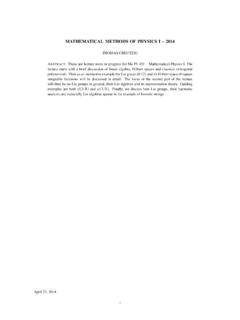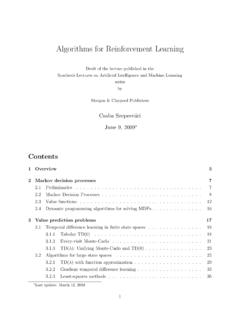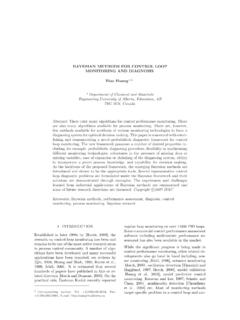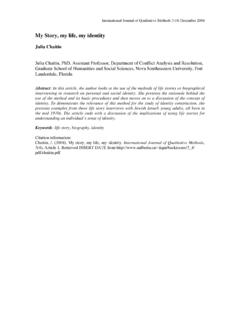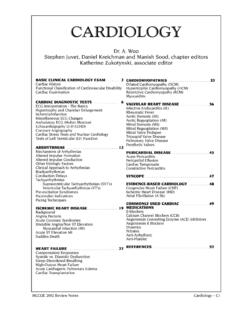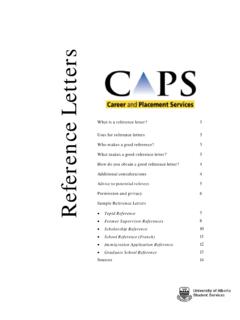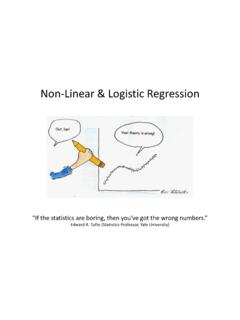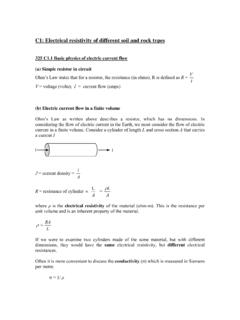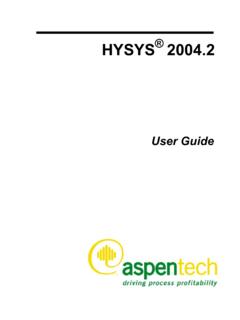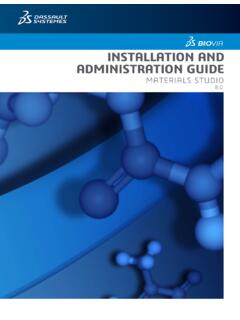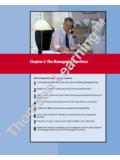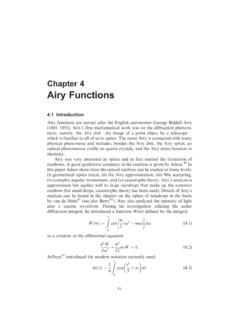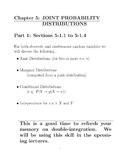Transcription of Chapter 5. Measurable Functions 1. Measurable Functions
1 Chapter 5. Measurable Functions 1. Measurable FunctionsLetXbe a nonempty set, and letSbe a -algebra of subsets ofX. Then (X, S) is ameasurable space. A subsetEofXis said to be Measurable ifE this Chapter , we will consider Functions fromXtoIR, whereIR := IR { } {+ }is the set ofextended real numbers. For simplicity, we write for + . The setIR isan ordered set: < x < forx functionffromXtoIR is calledmeasurableif, for eacha IR,{x X:f(x)> a}is a Measurable a function from a Measurable space(X, S)toIR. Then thefollowing conditions are equivalent:(1)fis Measurable ;(2) for eacha IR,f 1([a, ])is Measurable ;(3) for eacha IR,f 1([ , a))is Measurable ;(4) for eacha IR,f 1([ , a])is Measurable ;(5) the setsf 1({ })andf 1({ })are Measurable , and for each pair of real numbersaandbwitha < b,f 1((a, b))is (1) (2):f 1([a, ]) = n=1f 1((a 1/n, ]).(2) (3):f 1([ , a)) =X\f 1([a, ]).(3) (4):f 1([ , a]) = n=1f 1([ , a+ 1/n)).(4) (5): If (4) is true, thenf 1([ , b)) = n=1f 1([ , b 1/n]) is measur-able.]]]
2 It follows that the setf 1((a, b)) =f 1([ , b))\f 1([ , a]) is ,f 1({ }) = n=1f 1([ , n]) andf 1({ }) =X\ n=1f 1([ , n])are Measurable .(5) (1):f 1((a, ]) =f 1({ }) ( n=1f 1((a, a+n))).As a consequence of the above theorem, we see that a continuous function from IR toIR is Lebesgue two functionsfandgfrom a nonempty setXtoIR, definef g(x) := max{f(x), g(x)}andf g(x) := min{f(x), g(x)}, x , letf+:=f 0 andf := ( f) 0. We callf+thepositive partoffandf thenegative partoff, Measurable Functions , then the three sets{x X:f(x)> g(x)},{x X:f(x) g(x)}and{x X:f(x) =g(x)}are all Measurable . Moreover, the functionsf g,f g,f+,f , and|f|are all set{x X:f(x)> g(x)}= r QQ({x X:f(x)> r} {x X:g(x)< r})is Measurable , since it is a countable union of Measurable sets. It follows that the set{x X:f(x) g(x)}=X\{x X:g(x)> f(x)}is Measurable . Consequently, the set{x X:f(x) =g(x)}={x X:f(x) g(x)} {x X:g(x) f(x)}is IR, we have{x X:f g(x)> a}={x X:f(x)> a} {x X:g(x)> a}and{x X:f g(x)> a}={x X:f(x)> a} {x X:g(x)> a}.
3 Hence,f gandf gare Measurable . In particular,f+andf are Measurable . Fora 0, we have{x X:|f(x)| a}=X. Fora >0 we have{x X:|f(x)| a}={x X:f(x) a} {x X:f(x) a}.Hence,|f|is arithmetical operations on IR can be partially extended toIR. Forx IR, definex+ ( ) = ( ) +x= andx ( ) = ( ) x= .Moreover, we define(+ ) + (+ ) = (+ ) ( ) = + and ( ) + ( ) = ( ) (+ ) = .2 But(+ ) + ( ),(+ ) (+ ),and ( ) ( )are not defined. Thus, forx, y IR,x+yis well defined if and only if{x, y}6={ ,+ }.Multiplication onIR is defined as follows:( )( ) = + ,( )( ) = ,and forx IR,x( ) = ( )x={ ,forx >0,0,forx= 0, ,forx < two Functions from a nonempty setXtoIR. The productfgis definedto be the function that mapsx Xtof(x)g(x) IR. If{f(x), g(x)} 6={ ,+ }for everyx X, then the sumf+gis defined to be the function that mapsx Xtof(x) +g(x) IR. The differencef gis defined to bef+ ( g). It is well defined if{f(x), g(x)} 6={ ,+ }for everyx X. For example, for a functionf:X IR,f+(x) = impliesf (x) = 0, andf (x) = impliesf+(x) = 0.}
4 Hence,f++f andf+ f are well defined. In fact,|f|=f++f andf=f+ f .Theorem two Measurable Functions from a Measurable space(X, S)toIR. Thenf+gis a Measurable function, provided{f(x), g(x)}6={ ,+ }for everyx X. Moreover,fgis also a Measurable IR, the functiona gis Measurable . Moreover, we have{x X:f(x) +g(x)> a}={x X:f(x)> a g(x)}.By Theorem the set{x X:f(x)> a g(x)}is Measurable . Hence, for everya IR,{x X:f(x) +g(x)> a}is Measurable . This shows thatf+gis thatf 0 andg 0. Let QQ+:={r QQ :r >0}. Fora <0, we have{x X:f(x)g(x)> a}=X. Fora 0, we have{x X:f(x)g(x)> a}= r QQ+({x X:f(x)> r} {x X:g(x)> a/r}).As a countable union of Measurable sets, the set{x X:f(x)g(x)> a}is shows thatfgis Measurable wheneverf 0 andg let us consider the general case. Writef=f+ f andg=g+ g . By ,f+,f ,g+, andg are all Measurable . It can be easily verifies that, for everyx X,f(x)g(x) =h1(x) h2(x), whereh1:=f+g++f g andh2:=f+g +f g+. By whathas been proved,h1andh2are Measurable . Consequently,fg=h1 h2is 2.
5 Limits of Measurable FunctionsLetAbe a nonempty subset ofIR. Then supAand infAexist as elements ofIR. Fora sequence (xn)n=1,2,..of elements inIR, definesk:= sup{xn:n k}andtk:= inf{xn:n k}, k , definelim supn xn:= inf{sk:k IN}and lim infn xn:= sup{sk:k IN}.If lim supn xn= lim infn xn=x, then we write limn xn=x. Let (xn)n=1,2,..and (yn)n=1,2,..be two sequences of real numbers such that limn xn=x IR andlimn yn=y IR. Ifx+yis well defined, then limn (xn+yn) =x+ (fn)n=1,2,..be a sequence of Measurable Functions from a measurablespace(X, S)toIR. Forx X, defineg1(x) := sup{fn(x) :n IN}, g2(x) := inf{fn(x) :n IN},g3(x) := lim supn fn(x), g4(x) := lim infn fn(x).Then the functionsg1,g2,g3, andg4are all Measurable . Moreover, iff(x) = limn fn(x)exists for everyx X, thenfis eacha IR, the setsg 11((a, ]) = n=1f 1n((a, ]) andg 12([ , a)) = n=1f 1n([ , a))are Measurable , sog1andg2are , fork IN andx X, letuk(x) := sup{fn(x) :n k}andvk(x) := inf{fn(x) :n k}.Theng3(x) = inf{uk(x) :k IN}andg4(x) = sup{uk(x) :k IN}forx X.
6 By whathas been proved,ukandvkare Measurable for everyk IN. Consequently, bothg3andg4are , iff(x) = limn fn(x) exists for everyx X, thenf=g3=g4, (fn)n=1,2,..be a sequence of Functions from a nonempty setXto IR. We say thatthe sequenceconverges uniformlyto a functionf:X IR if, for any >0, thereexists a positive integerNsuch that|fn(x) f(x)|< whenevern Nandx a nonempty set. Thecharacteristic functionof a subsetEofXis thefunction given by E(x) :={1 ifx E,0 ifx functionffromXtoIR is said to besimpleif its rangef(X) is a finite (X) ={a1, .. , ak}. Thenfcan be represented asf=k j=1aj Aj,whereAj:=f 1({aj}),j= 1, .. , a function from a nonempty setXtoIR. Then the followingstatements are true.(1) There exists a sequence(fn)n=1,2,..of simple Functions from the setXtoIRsuch thatlimn fn(x) =f(x)for everyx X.(2) Iffis nonnegative, the sequence can be so chosen that0 fn fn+1 ffor alln IN.(3) Iffis bounded, the sequence can be so chosen that it converges uniformly tofonX.}
7 (4) If(X, S)is a Measurable space andfis Measurable on(X, S), then eachfn(n IN)can be chosen to be IN, letIn:= [n, ] andIn,k:=[k 12n,k2n), k= 1,2, .. , [0, ] is the union ( n2nk=1In,k) Inof mutually disjoint first thatf 0. Forn IN, letAn:=f 1(In) andAn,k:=f 1(In,k) for1 k n2n. ThenXis the union ( n2nk=1An,k) Anof mutually disjoint sets. We definefn:=n2n k=1k 12n An,k+n a simple function fromXto IR. Iffis Measurable , then the setsAnandAn,kare Measurable . Hence,fnis Measurable for eachn Xandf(x) = , thenx Anfor alln IN. Hence,fn(x) =nfor alln follows that limn fn(x) = =f(x). Supposef(x)< . Ifn IN andf(x) n,thenx Anandfn(x) =n f(x). Iff(x)< n, thenx Acnand hencex An,kfor some5k {1, .. , n2n}. It is easily seen thatfn(x) = (k 1)/2nand (k 1)/2n f(x)< ,0 f(x) fn(x)< above inequalities are valid for alln > f(x). Consequently, limn fn(x) =f(x) foreachx X. Moreover, iffis bounded, then there exists somen0 IN such thatf(x)< n0for allx X. Thus, the above argument shows that the sequence (fn)n=1,2.]
8 Convergesuniformly 0, we have proved 0 fn ffor alln IN. Let us showfn fn+1foralln IN. Supposex X. Iff(x) n, thenfn+1(x) n fn(x). Iff(x)< n,thenx An,kfor somek {1, .. , n2n}. SinceIn,k=In+1,2k 1 In+1,2k, we haveAn,k=An+1,2k 1 An+1,2k. Thus,x An+1,2k 1 An+1,2k, and hencefn+1(x) 2k 1 12n+1=k 12n=fn(x).This completes the proof for the casef the general case, we writef=f++f , wheref+=f 0 andf = ( f) 0. Bywhat has been proved, we can find two sequences (gn)n=1,2,..and (hn)n=1,2,..of simplefunctions fromXto IR such that limn gn(x) =f+(x) and limn hn(x) =f (x) foreachx X. Letfn(x) :=gn(x) hn(x) forx X. Sincef+(x) f (x) is well definedfor eachx X, we have limn fn(x) =f+(x) f (x) =f(x). Iffis bounded, thenf+andf are bounded. Hence, (gn)n=1,2,..can be so chosen that it converges tof+uniformly onX, and (hn)n=1,2,..can be so chosen that it converges tof uniformly , (fn)n=1,2,..converges tofuniformly onX. Finally, iffis Measurable , thenf+andf are Measurable . Hence, forn IN,gnandhncan be chosen to be ,fnis Measurable for everyn IN.
9 This completes the proof of the theorem. 3. Modes of ConvergenceLet (X, S, ) be a measure space. A Measurable setNis called a -null set if (N) = property is said to hold -almost everywhereif there is a null setNsuch that it holdsfor allx X\N. If the measure is clear from the context, the reference to will measure space (X, S, ) is calledcompleteif every subset of a -null set is mea-surable. If this is the case, then the measure is said to be complete. For example, theLebesgue measure on the real line is (X, S, )be a complete measure space. Then the following statementsare true.(1) For two functionsfandgfromXtoIR, iffis Measurable andg=falmost every-where, thengis Measurable .(2) If(fn)n=1,2,..is a sequence of Measurable Functions fromXtoIR, and iffis a functionfromXtoIRsuch thatf(x) = limn fn(x)holds for almost everyx X, (1) LetE:={x X:f(x) =g(x)}. ThenEcis a null set. Fora IR, we have{x X:g(x)> a}={x E:g(x)> a} {x Ec:g(x)> a}.Moreover,{x E:g(x)> a}={x E:f(x)> a}={x X:f(x)> a}\{x Ec:f(x)> a}.
10 Since is a complete measure andEcis a null set, both sets{x Ec:g(x)> a}and{x Ec:f(x)> a}are Measurable . Furthermore, the set{x X:f(x)> a}ismeasurable, becausefis Measurable . This shows that{x X:g(x)> a}is measurablefor everya IR. Therefore,gis a Measurable function.(2) There exists a null setNsuch that limn fn(x) =f(x) for allx X\N. LetE:=X\N,g:=f E, andgn:=fn Efor eachn IN. Since eachfn(n IN) isa Measurable function andEis a Measurable set, eachgn(n IN) is Measurable . Butg(x) = limn gn(x) for allx X. Hence, by Theorem ,gis Measurable . Furthermore,f=gforx E=X\N. By part (1),fis a Measurable (fn)n=1,2,..be a sequence of Functions from a nonempty setXto IR, and letfbe a function fromXto IR. We say that (fn)n=1,2,..converges tofpointwiseif limn fn(x) =f(x) for everyx X. We say that (fn)n=1,2,..converges tofuniformlyif, for any >0, there exists a positive integerNsuch that|fn(x) f(x)|< whenevern Nandx (X, S, ) be a measure space. Suppose that (fn)n=1,2,..is a sequence of functionsfromXto IR andfis a function fromXto IR.
